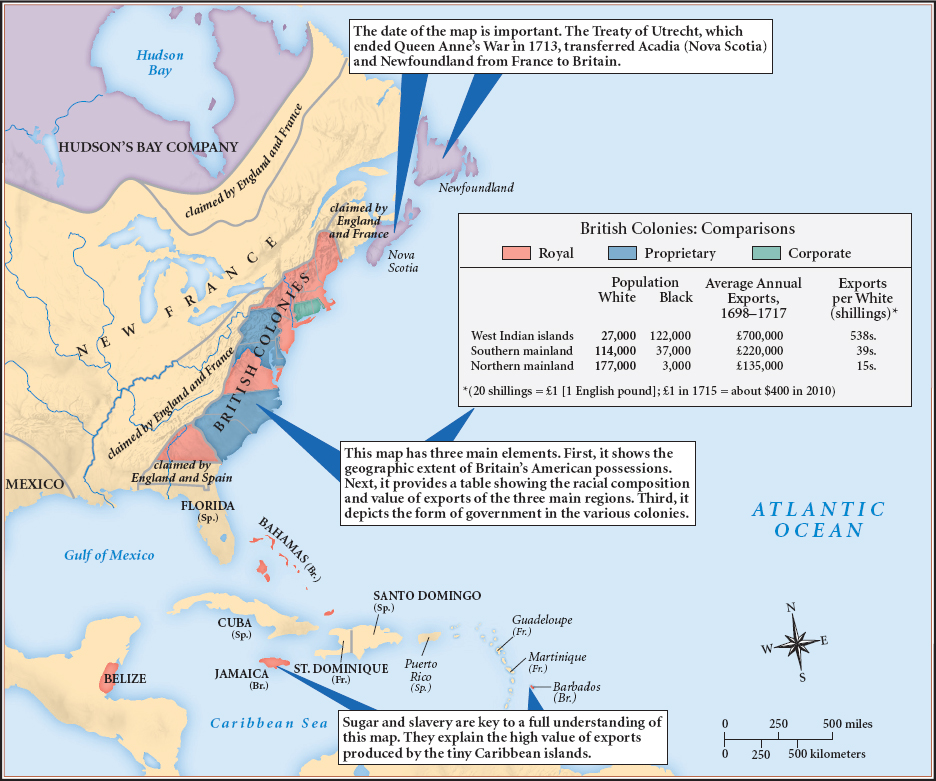AP-Style Short Answer Questions for Part 2
1. Question 1 is based on Map 3.2: The Growing Power of American Merchants, 1750.

Use your knowledge of United States history and Map 3.2 to answer parts A, B, and C.
A) Identify and briefly explain how ONE element of the British-controlled transatlantic trade shaped the economy of North America in this period.
B) Identify and briefly explain how ONE element of the British-controlled transatlantic trade shaped the culture of North America in this period.
C) Identify and briefly explain how the element you chose for EITHER part A OR part B influenced the political context of the British North American colonies by the mid-eighteenth century.
Question 102.1
2. Question 2 is based on the painting by John Collet of George Whitefield Preaching.

Use this painting and your knowledge of United States history to answer parts A, B, and C.
A) Explain ONE of the ways the artist expressed the typical actions of ministers during the Great Awakening.
B) Explain ONE of the ways the artist expressed the typical crowds who attended the revivals of the Great Awakening.
C) Explain how the factor you identified in either part A or part B helped to shape the colonial response to its conflict with Great Britain between 1763 and 1776.
Question 102.2
3. The population of Britain’s North American colonies grew and diversified after 1660. Use your knowledge of United States history to answer parts A and B.
A) Identify and briefly describe TWO of the non-English groups who came to the colonies in increasing numbers between 1660 and 1763.
B) Briefly explain how the influence of ONE of the two groups identified in part A caused conflict in the colonies.
Question 102.3
4. Question 4 is based on the following two passages.
“In 1640 Charles I’s colonial subjects had numbered some fifty thousand people, most of them recent arrivals and the overwhelming majority of them of English origins. In 1660, the colonial population had risen to two hundred thousand. Many of these people were non-English, and the bulk of those . . . had come in some state of unfreedom. . . . The colonial environment was diverse in other ways as well: its religious diversity was unrivaled anywhere else in the king’s realm . . . [and] regional economic identities . . . had been born.”
Carla Pestana, The English Atlantic in an Age of Revolution, 1640–1660, published in 2004
“By the end of the seventeenth century . . . the empire had been put back together. . . . In the first six decades of the century ahead, the English would pursue their national goals, building internal strength, waging expansive but ultimately victorious war with France and other enemies, and directing affairs of empire in such a way that the goals of domestic well-being, security, and prestige all progressed. And in America, during those same six decades, the colonists would experience economic, population, social and cultural growth, emerging at the end of the era as something unique in western experience—a new people, operating within a novel framework of social organization.”
Carl Ubbelohde, The American Colonies and the British Empire, 1607–1763, published in 1975
Using your knowledge of U.S. history and the two excerpts above, answer parts A, B, and C.
A) Briefly explain Carla Pestana’s main point in the first excerpt.
B) Briefly explain Carl Ubbelohde’s main point in the second excerpt.
C) Account for the difference between Pestana’s and Ubbelohde’s points of view.